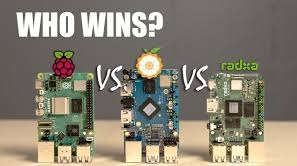The Raspberry Pi 5 and Orange Pi 5 are two great options in the fast-changing world of single-board computers. Each has its own qualities that make it a good fit for certain types of projects. Choosing between them has less to do with numbers and more to do with how well their features fit with your technical goals and level of comfort.
The Raspberry Pi 5 stands out because it has a very mature ecosystem and a huge community—a busy city of developers, teachers, and hobbyists that keeps software updates coming quickly and provides a lot of resources. It has a quad-core BCM2712 processor that runs at 2.4 GHz and a VideoCore VII GPU that works with it to make sure that dual 4K micro HDMI output is smooth. It also uses very little power, only about 4W. Its combination of two USB 3.0 ports, Gigabit Ethernet, and strong wireless connectivity (Wi-Fi 5 GHz and Bluetooth 5.0) makes it easy to use for a wide range of IoT, educational, and video streaming apps. The Raspberry Pi OS is very trustworthy because it is well-made and easy to use, which makes it perfect for embedded and multimedia applications that need to work together without any problems.
On the other hand, the Orange Pi 5 Ultra uses a lot of raw computing power, with an octa-core RK3588S SoC running at 2.4 GHz and up to 16 GB of LPDDR5 RAM. This hardware boost means that multi-core performance is 30–50% better than the Pi. This is especially helpful for parallel workloads, AI/ML inference, and playing back high-resolution 8K video. The ARM Mali-G610 MP4 GPU is quite powerful and designed for heavy media processing and graphics. PCIe Gen 3 ports and M.2 expansion slots also make it possible to use industrial-grade storage and data speed, which is a big plus for professional and edge computing deployments. Still, this potential is somewhat mitigated by a smaller, less unified community and software that is still being developed, as well as Raspberry Pi’s more polished platform, which has a little greater power demand of about 5W and a higher price tag to match these beefier characteristics.
Important things to think about when making the choice are:
1. **Processing Power and Performance**: The Orange Pi’s eight-core CPU is far faster than the Pi’s four-core processor when it comes to multi-threaded activities, making it perfect for projects that require a lot of computing power. On the other hand, Raspberry Pi has higher single-core performance and software efficiency, which makes it a good choice for applications that don’t need a lot of parallel processing.
2. **Memory and Storage**: Orange Pi can handle memory-intensive apps better because it has up to 16 GB LPDDR5 RAM. Raspberry Pi can only handle up to 8 GB LPDDR4X RAM, but it has a well-established, flexible storage ecosystem.
3. **Connectivity and Expansion**: Raspberry Pi is very flexible for multimedia and IoT integration because it has wifi capabilities and two HDMI connectors. Orange Pi handles expansion better with better PCIe Gen 3 compatibility and M.2 slots, which are great for managing a lot of data and for specific industrial use.
4. **Software Support and Community**: The Raspberry Pi has a huge and active user base that creates a lot of tutorials, solves bugs quickly, and adds new features to the OS all the time. This makes it much easier to fix problems. The Orange Pi community is getting bigger, but it is still split up, and the software support isn’t as good, therefore it needs more technical skill.
5. **Intended Use Cases**: Raspberry Pi is great for education, hobby projects, and reliable multimedia apps since it works well and is easy to use. Orange Pi gets developers and experts’ attention since it has the best power for AI workloads, video processing, and advanced parallel computation.
6. **Price and Availability**: The Raspberry Pi 5 costs about $60 and is a good blend of price and performance. The Orange Pi models cost more but provide you more raw computing and graphics power.
In the end, the **Raspberry Pi 5** is a very stable and flexible companion, especially for people who value a large support network and the ease of wireless. On the other hand, the **Orange Pi 5 Ultra** is a powerhouse for people who are brave enough to use cutting-edge specifications and take on tough multimedia or AI jobs, even though the software environment isn’t as mature yet. This pick will be heavily influenced by what your project needs and how much you want to learn more about technology.
By seeing these boards as more than just competitors and as specialized parts of the larger maker and industrial symphony, you give your projects the chance to hit the right note, whether it’s with the reliable and well-known Raspberry Pi 5 or the daring and powerful Orange Pi 5.






